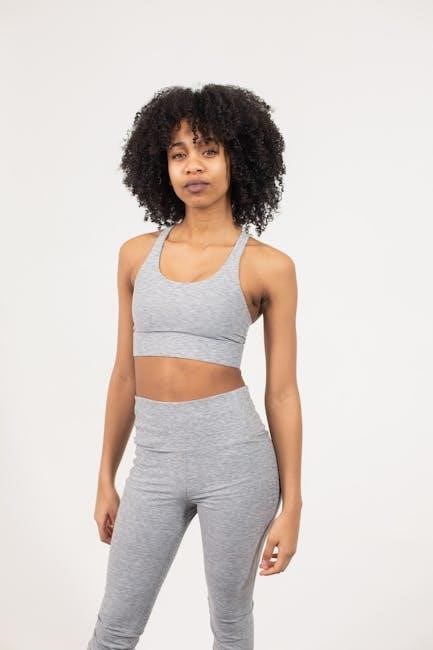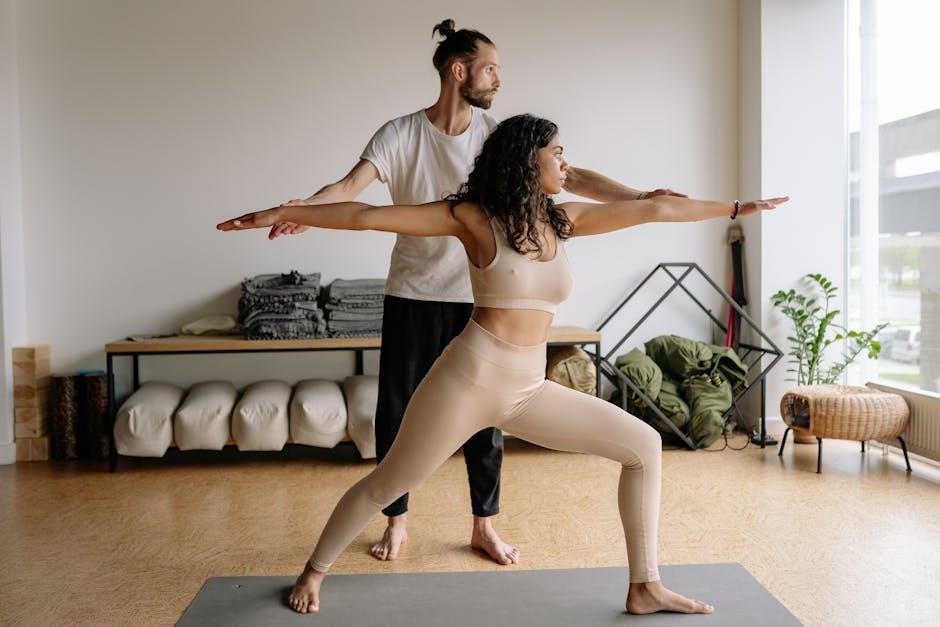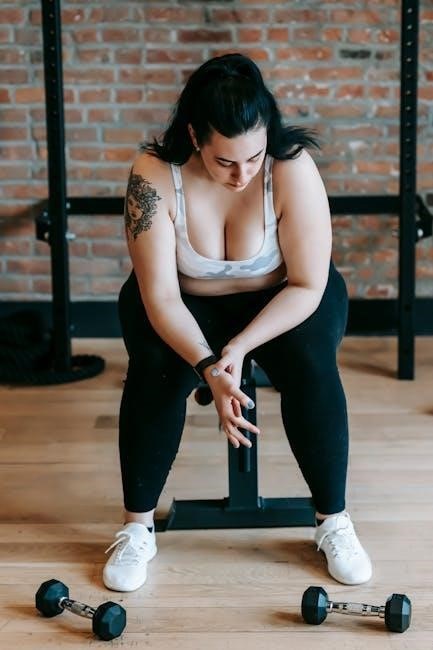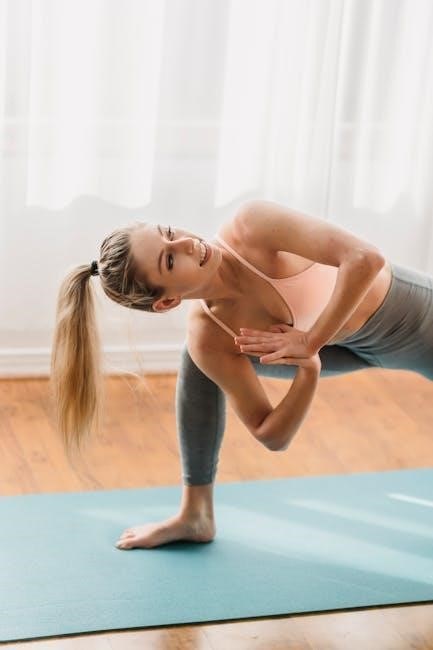Bra fitting is an essential aspect of personal style, ensuring comfort and confidence. Many people struggle with finding the right size, but it’s a skill that can be mastered with guidance.
Why Proper Bra Fit Matters
A well-fitting bra is crucial for both comfort and confidence. Poorly fitting bras can cause discomfort, lead to health issues like back pain, and even affect posture. Proper fit ensures breasts are supported, reducing strain on shoulders and improving overall alignment. It also enhances appearance, creating a smoother silhouette and boosting self-esteem. Many people underestimate the impact of an ill-fitting bra, but it can make a significant difference in daily comfort and confidence. Addressing fit issues early can prevent long-term discomfort and ensure a more enjoyable, active lifestyle.
Understanding Bra Sizes and Standards
Bra sizes are determined by two key measurements: band size and cup size. The band size is measured around the ribcage, just under the breasts, while the cup size represents the difference between the bust and band measurements. However, bra sizing standards vary between brands and regions, leading to inconsistencies. For example, a size 34B in one brand may not fit the same as a 34B in another. Understanding these variations is crucial for finding the right fit. Additionally, “sister sizes” allow for flexibility, as moving up or down in band or cup size can provide a similar fit. Always try bras on to ensure accuracy, as sizes are not universal.

Preparing for a Bra Fitting
Wear a non-padded bra for an accurate fit. Bring clothes to try on over bras. Be honest about your needs and preferences. Take notes for future reference.
What to Wear to a Fitting
Wear a non-padded, wire-free bra for an accurate fit. Choose comfortable, form-fitting clothing like a simple t-shirt or tank top. Avoid tight or bulky garments. Bring a lightweight top to try over bras. Consider wearing your usual undergarments for a realistic fit. If trying sports bras, wear a sports-friendly outfit. Keep jewelry minimal to avoid interference. Arrive without lotions or oils on your skin for better results. Bring a jacket or robe for privacy during the fitting process. This ensures a smooth and effective bra-fitting experience.
How to Measure Your Band Size
To measure your band size, wear a non-padded, snug-fitting bra. Use a flexible tape measure and wrap it around your ribcage, just under your bust. The tape should feel comfortable but not too tight. Keep the measure level and parallel to the floor. Take note of the measurement in inches. If the number is odd, round up to the next even number for your band size. Some fitters add 1-2 inches for comfort. Ensure the tape isn’t twisted or riding up for an accurate fit. This step is crucial for determining your base size and ensuring proper support.
How to Measure Your Cup Size
To measure your cup size, wear a snug-fitting, non-padded bra. Wrap a tape measure around the fullest part of your bust, keeping it level and parallel to the floor. Ensure the tape isn’t too tight or twisted. Subtract your band size from this bust measurement. The difference determines your cup size: 1 inch for A, 2 inches for B, and so on. For example, a 35-inch bust and 32-inch band results in a 3-inch difference, which corresponds to a C cup. If your bust measurement is larger, consider trying larger cup sizes. Professional fitters can also assist for accuracy.

Signs of a Good Fit
A well-fitting bra provides comfort and support without digging or gapping. The band stays level, straps don’t slide, and cups fully encase breasts. The center gore rests flat against your chest, ensuring proper alignment and distribution of weight for all-day ease.
Key Characteristics of a Well-Fitting Bra
A well-fitting bra offers seamless comfort and support. The band should sit snugly but not feel restrictive, staying level around your torso. Straps should remain in place without digging into your shoulders, and cups should fully encase your breasts without gapping or spilling over. The center gore (the piece between the cups) should lie flat against your chest, ensuring proper alignment. The bra should move with you, staying in place during daily activities, and provide the right level of lift and separation for your body. Proper fit enhances both posture and confidence.
Common Mistakes People Make
Many individuals make mistakes when it comes to bra fitting, such as relying on outdated sizes or assuming their size remains constant. Neglecting to measure regularly and ignoring discomfort are also common errors. Some people prioritize style over fit, leading to poor support. Others fail to adjust straps properly or misunderstand cup sizing. Additionally, not seeking professional fittings or relying solely on online guides can result in improper fit. Addressing these mistakes ensures a more comfortable and supportive bra-wearing experience. Awareness and regular check-ins with sizing can make a significant difference in overall comfort and confidence.

Professional Bra Fittings
A professional bra fitting offers personalized expertise, ensuring accurate measurements and tailored recommendations. Expert fitters guide you through the process, helping you find the perfect fit for comfort and confidence.
What Happens During a Professional Fitting
During a professional bra fitting, an expert fitter will assess your current bra and measure your band and cup size. They’ll analyze how the bra sits on your body, ensuring proper alignment and support. The fitter will then bring in several styles and sizes for you to try on, providing feedback on fit and comfort. They’ll check for key characteristics like the band sitting level and cups covering your breast tissue fully. Adjustments are made to straps and bands for optimal fit. The process concludes with personalized recommendations to address specific needs, such as minimizing gapping or digging, and suggesting styles suited to your activity level or body type.
When to Get Fitted (Including Teens)
Professional bra fittings are recommended for teens as they begin to develop breast tissue, typically around age 11, though some may need bras earlier or later. Adults should get refitted after significant weight changes, pregnancy, or other body shifts. Teens should be fitted when they notice their breasts beginning to develop, ensuring proper support from the start. Regular fittings every 1-2 years are advised to accommodate growth spurts and changes in body shape. This helps maintain comfort and confidence, addressing any issues like gapping or digging early on.
Choosing the Right Style
Selecting the right bra style depends on your activities and body type. Ensure proper fit and comfort while choosing styles tailored to your daily needs and preferences;
How to Select Bras for Different Activities
Choosing the right bra for your activities ensures comfort and support. For sports, opt for a sports bra with moisture-wicking fabric and high-impact support. Everyday wear calls for breathable, seamless bras that minimize visibility under clothing. For formal events, consider lace or push-up bras for a polished look. Adjust your selection based on your cup and band size, ensuring a snug fit. Professional fittings can help you identify the best styles for your needs. Experiment with different designs to find what works best for your lifestyle and body type, enhancing both comfort and confidence.
Adjusting Your Bra for Maximum Comfort
To ensure maximum comfort, adjust your bra regularly. The band should feel snug but not tight, with the straps evenly distributed to avoid digging into your shoulders. Cups should fully contain your breast tissue without gaping or spilling over. If the band rides up, it may be too loose, while tightness can cause discomfort. Loosen overly tight straps and check for proper alignment. Regularly inspect and adjust your bra throughout the day, especially after weight changes or activity. Proper adjustments enhance support, reduce discomfort, and extend the bra’s lifespan, ensuring a confident and comfortable fit all day long.

Specialized Bras
Specialized bras cater to unique needs, such as sports bras for high-impact activities or medical bras for post-surgery support. These designs prioritize functionality and comfort for specific purposes.
How to Fit Sports Bras
Fitting a sports bra requires ensuring a snug, supportive fit without restricting movement. The band should sit level and stay in place during activity, while the cups should fully contain breast tissue. Opt for moisture-wicking fabrics to keep cool and dry. Choose styles based on activity intensity—high-impact sports need maximum support. Adjustable straps can provide a customized fit, but ensure they don’t dig into shoulders. A professional fitting can help determine the best style for your needs. The bra should feel comfortable yet secure, allowing for a full range of motion without shifting or causing discomfort during exercise.
Tips for Finding the Perfect Bra
Finding the perfect bra involves understanding your measurements and needs. Measure your band and cup size accurately, either at home or with a professional fitting. Wear a well-fitting, non-padded bra during try-ons for the best results. Experiment with different styles to find what suits your body and activities. Pay attention to fabric quality and features like underwire or wire-free options for comfort. Ensure the bra sits level, with no gapping or digging. Check the fit regularly, as sizes can change over time. Don’t hesitate to seek advice from fitters or online guides to ensure the best fit for support and confidence.
Troubleshooting Common Issues
Address discomfort by adjusting straps or trying a different size. Gapping or digging can often be resolved with proper fitting or style adjustments for better support.
What to Do If Your Bra Feels Uncomfortable
If your bra feels uncomfortable, check for signs like gapping, digging, or ill-fitting cups. Adjust the straps or try a different style, ensuring proper band fit. If issues persist, consider professional fitting or exploring alternative sizes. Pay attention to changes in your body that may require a new size. Addressing discomfort early ensures better support and confidence. Remember, the right fit should feel seamless and provide all-day comfort without restriction or pain.
How to Address Gapping or Digging
If your bra gaps or digs, it may not be the right fit. Gapping occurs when the cups don’t lie flat against your body, while digging happens when the band or straps feel too tight. To fix gapping, try a smaller cup size or adjust the straps. For digging, ensure the band sits level and isn’t too snug. If issues persist, consider a different style, like a balconette or full-coverage bra, or consult a professional fitter. Proper adjustments can eliminate discomfort and ensure a supportive, flattering fit.
Proper bra fitting is key to comfort and confidence. Regular check-ins ensure the best support. Seek professional guidance for a perfect fit and happy wardrobe.
Final Tips for Maintaining a Great Fit
- Regularly reassess your bra size, as it can change due to weight fluctuations or hormonal shifts.
- Rotate your bras to extend their lifespan and prevent over-stretching.
- Check for signs of wear, like frayed straps or bent underwires, and replace bras as needed.
- Wash bras gently by hand or in a lingerie bag to preserve their shape and elasticity.
- Store bras properly to avoid deformation and maintain their structure.
By following these tips, you can ensure your bras remain comfortable and supportive over time.
When to Get Refitted
Life changes can affect your bra size, so regular refittings are essential. Weight fluctuations, hormonal shifts, pregnancy, or medical conditions can alter your measurements. Teens and young adults may need frequent fittings due to growth spurts. If your bra feels uncomfortable, rides up, or the cups gape, it’s time to reassess. Schedule a professional fitting every 6-12 months or after significant life events, like childbirth or surgery. Pay attention to changes in how your bras fit and adjust accordingly to maintain comfort and support. Regular check-ins ensure your bras continue to meet your needs.
